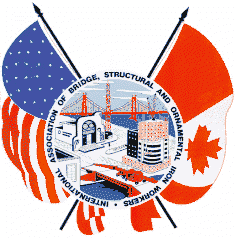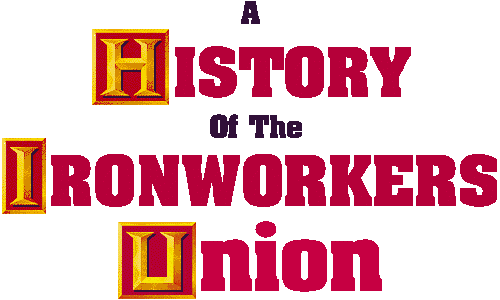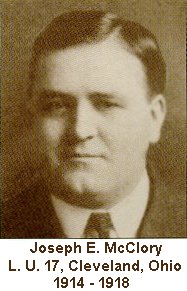|
|
|
|
Our History
A Union is Born
The Turbulent Years
The Conspiracy Trials
The Beginning of the
Morrin Era
The Depression and a New
Deal For Labor
World War II
Ironworkers Grow in the
1950's Part Two Part Three
John H. Lyons Jr.
Elected President
The Tradition Continues
Pathways to the 21st
Century Under The Leadership of General President Jake West
|
Part Two Although these were trying times, the International continued to function. Three months after the trial, the International Association called the postponed Sixteenth International Convention from February 24 through March 6, 1913, in Indianapolis. The loyal delegates exhibited a rock-hard "semper fi" stance and reelected Ryan as General President, in the face of his conviction. Harry Jones, Local No. 40, New York, N. Y. was elected Secretary/Treasurer. J. E. McClory , Local 17, Cleveland, Ohio, was elected First Vice President. A. F. of L. President Samuel Gompers addressed the delegates on February 27, 1913. He said among other things that "The Bridge and Structural Iron Workers are hard-working men, who are doing wonderful service to society; who are taking their lives in their own hands every day and every hour of the day they work. Without them, and without that service, modern industrial and commercial structures would be an impossibility." He also said in reference to the trials of the International and local union officers that "I am not in position to constitute myself the censor of their judges, or of men, nor am I in position to say that these men are innocent, and I am not going to say that they are guilty; but there is one thing which was evident to every fair-minded observer, and that is the entire case was conducted with a prejudice and bitter partiality against the men, that it raises the question of an honest doubt in the minds of honest men, and it was my pleasure , as I felt it was my duty, when the opportune moment came, the time to appear before the Judiciary Committee of the United States Senate, to set forth my views as to who was responsible after all." Five men were granted new new trials by the Appellate Court, two decisions were reversed the other convictions were upheld. The convicted men took their cases to the United States Supreme Court, which refused to review them. The Union appealed to President Woodrow Wilson on behalf of the men who were still out on bond. President Wilson pardoned four men,. The remaining Union men including General President Frank M. Ryan, John T. Butler, a former General President, and second Vice President Paul J. Morrin, a future General President, had to report to Leavenworth on June 25, 1914, to serve their sentences ordered by Judge Anderson on December 31, 1912. For present day Ironworkers, the dynamite conspiracy and the bombings are neither a point of pride nor a reason for guilt. The Iron Worker leadership had no real option other than to succumb in the open shop battle, which was unacceptable to them. In the context of the times their behavior can be understood, if not condoned. (After all, Thomas Jefferson bought and sold slaves and had children by them.) An immoral act is not relative; its nature cannot be changed by custom or circumstance. Trend or times can merely help explain such an act, not excuse it. McNamara, Ryan, Clancy, Butler, Morrin and the others may have done what they thought they had to do to preserve the International Association. And despite other consequences of the dynamite campaign, they did save the Union. The International Officers stretched the limits of zeal in a righteous cause. Their strategy and tactics suffered - not the cause or validity of unionism.
Frank Ryan resigned as General President when he entered Leavenworth Federal Prison. The International Executive Board members then convened and appointed First Vice President Joseph McClory as acting General President effective July 14, 1914, to serve until the upcoming convention. At the Seventeenth International Convention held September 21st to 30th in Peoria, Illinois McClory was elected General President. It was at this Convention that a resolution was made to change the name of our International Association to "The International Association of Bridge, Structural and Ornamental Iron Workers. The resolution was amended to include "Pile Drivers". Therefore the name of our organization became: " The International Association of Bridge, Structural and Ornamental Iron Workers and Pile Drivers" Joseph McClory was a native New Yorker; his family, however, moved to Cleveland several years after his birth in 1877. His father was lured by a better job. Young Joe was educated by the Nuns at St. Malachi's School, and they taught him well. In his late teens he was attracted to ironwork, and on March 12, 1898 was enrolled as a charter member of Local 17. Six weeks later while McClory was working on the Victoria Bridge over the St. Lawrence River, Spain declared war on the United States. McClory, an adventurous and a patriotic soul, as well, informed his foreman that he wanted to return home to enlist in the U. S. Army. He did and served honorably, as did a number of his fellow Ironworkers. (Since record keeping was somewhat casual in those days, no precise figure is available, just that "many Ironworkers....volunteered" for service during the short war.) After his discharge from the Army, McClory joined the Gold Rush to the Klondike which has started two years previously. The luck of the Irish eluded him, however, and he decided to go home again. His misfortune in not finding gold proved to be good fortune for the International Association. At the San Francisco Convention in 1915, after his first full year as President, McClory wired fraternal greetings to John J. McNamara at San Quentin and Frank Ryan, Eugene Clancy, and the other Ironworkers at Leavenworth. Three days later, Ryan sent a telegram to McClory to read to the delegaates expressing gratitude and appreciation from all sixteen Ironworkers in the Federal Prison. During McClory's years in office, he kept in touch with the Union men at Leavenworth through personal Visits and letters and always through Second Vice President William J. McCain, of Kansas City. (McCain had been Business Agent of Kansas City Local 10 and was indicted in the dynamite conspiracy case. Since there was no real evidence against the mild-mannered McCain, he was found not guilty. Other International and Local Union Officers visited the men, and brought tobacco and fruit. The visitors reported that at all times the Ironworker inmates were of good cheer, but from time to time John Butler and Henry Legleitner, of Pittsburgh, were confined to the hospital because of health problems. As evidence of their good spirits, the men formed Federal Iron Workers Local 1, of Leavenworth, with John Butler as Business agent. Frank Higgins in a letter to the International in September 1914, advised boomers and floaters "not to come this way looking for work just now." McClory was a huge man with a heart to match. He helped prepare a resolution to provide weekly payments of $25.00 to Mrs. Mary McNamara, the mother of Jon and James B. McNamara. He also appointed many of the men as part-time organizers, as they were released from prison beginning in 1915, thus helping them get a fresh start after they paid their debt to society. Some men stayed with the International a relatively short time. Others, such as former President John T. "Jack" Butler, who was not in the best of health, remained for a couple of years. Stalwarts John H. Barry, of St. Louis and James E. Munsey, of Salt Lake City, also stayed for extended periods. McClory looked forward to Frank Ryan's release; he wanted Ryan's assistance in keeping pile drivers in the International Association. This was not viewed as charity since the International could well use the expertise of the old hands and benefit from their experience.
Scroll to the top and click on "The Conspiracy Trials and Aftermath - 1912 to 1918 - Part Three"
[Home]
[Officers]
[Upcoming
Events] [Links
to Other Unions] |


 At
the Sixteenth International Convention, the delegates amended Section 19
of the Constitution which increased the number of Officers of the
International. The International Officers shall consist of a
President, First, Second, Third, Fourth, Fifth and Sixth Vice Presidents
and a Secretary/Treasurer. It was voted that the Executive Board
would consist of the President and all the Vice Presidents.
At
the Sixteenth International Convention, the delegates amended Section 19
of the Constitution which increased the number of Officers of the
International. The International Officers shall consist of a
President, First, Second, Third, Fourth, Fifth and Sixth Vice Presidents
and a Secretary/Treasurer. It was voted that the Executive Board
would consist of the President and all the Vice Presidents.